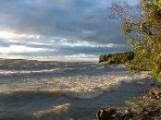Mussels’ strength about to double
Mussels’ strength about to double
New threat arrives in Lake Simcoe
Zebra mussels have a new partner in crime in their invasion of Lake Simcoe. They’re called quagga mussels.
“You’ve got a double whammy now,” said Will Wegman from the Ministry of Natural Resources’ Aurora office, with zebras inhabiting the shallows and the quaggas taking up residence in the deeper areas.
Quagga mussels, a close cousin of zebra mussels, were first discovered in Lake Simcoe in 2004. Although similar in appearance, the quagga species are more oval-shaped as opposed to the D-shaped zebras.
Quagga mussels, first discovered at Port Colborne in Lake Erie in 1989, are commonly found at depths of 90 meet or more, on sandy or muddy bottoms, while zebras prefer rocky bottoms.
Like zebra mussels, quaggas efficiently filter water and can produce more than one million eggs per female each spawning season.
Zebra mussels are filter feeders and each one can process about one litre of water each day, sucking out plankton and other organic matter. This leaves the water cleaner, but it also robs other aquatic life of a food source, causing a trickle-down effect in the food chain.
Mussels negatively affect baby fish that also feed on microscopic organisms, but if some fish, such as smallmouth bass, can survive into adulthood, they can thrive, Wegman said. That’s because the water is clearer, and smallmouth bass rely on keen eyesight.
Anecdotal evidence from anglers suggests the overall size of smallmouth bass has increased in recent years. Fifteen years ago, a tournament winner could haul in the big prize with their five-fish entry weighing between 22 and 23 pounds, said Wegman, an avid angler. Today, a winner’s five-fish total will tip the scales at more than 25 pounds.
Less organic matter also allows sunlight to penetrate deeper into the water, beneficial to underwater plants and also resulting in increased water clarity.
“It’s one of those double-edged swords,” Wegman said. “There’s no question it’s clearing, not cleaning, up the lake. But it’s also totally changed the whole ecosystem.”
Lake Erie, so badly polluted that it was labelled as a “dead lake” in the 1960s, is now being compared to the vibrant hues of the Caribbean. Ironically, it’s the invasive zebra mussels, which entered the Great Lakes about two decades ago, that has created these increasingly clear waters, leaving many to believe that the lake was becoming cleaner and healthier.
But it’s all an illusion.
The jury’s still out on the effect of zebra mussels on Lake Simcoe.
“It’s hard to say whether it’s good or bad,” Wegman said. “It has changed the waters to an extent ... and now we have aquatic life where we didn’t have it before.”
Those areas include the northern portion of Cook’s Bay, the Virginia Basin near Sutton, and close to the shores of northern Lake Simcoe. Lake Simcoe covers about 725 square kilometres.
One thing is certain.
“They’re here to stay,” Wegman said of zebra mussels. “All the predators in the world won’t eliminate them.”




1 Comments:
House Relocation Services Hyderabad
Bike Transportation Services hyderabad
Car Transportation Services hyderabad
International Packers and Movers Hyderabad
Cargo Services in Hyderabad
Post a Comment
<< Home